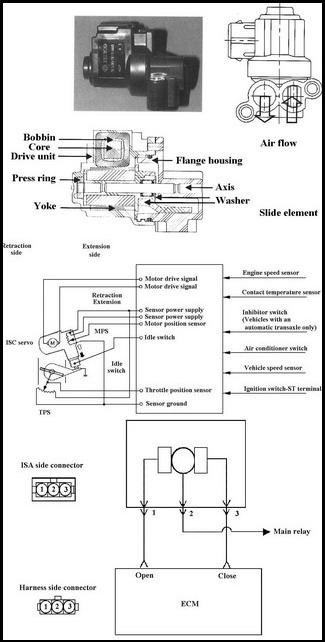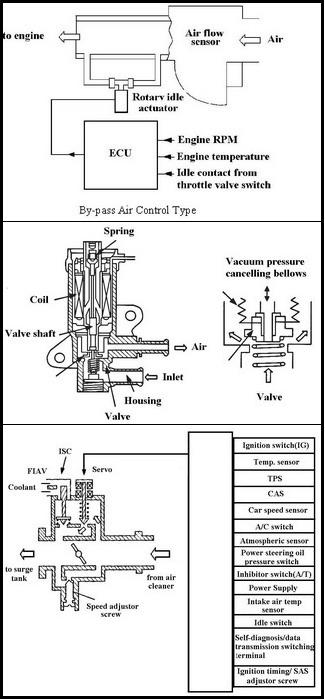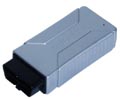- Idle Speed Actuator
- |
- Electrical Actuators
- |
- Repair Basics
- |
- Technical Info
- |
- Car Tech Info
- |
- MicroTronik
Idle Speed Actuator

Idle Speed Actuator Circuit

Idle Speed Actuator Types
1. General
ISA (Idle Speed Actuator) is installed at throttle body of engine and control air intake rate into engine depending on ECU signal in order to control idle rpm. Idling speed is controlled relying on a number of parameters including actual engine rpm, coolant temperature, air-conditioning system and headlamp operation status, etc. ECM transforms the information into ISA control signal for optimal idling control.2. Function
1) Optimal Fuel Consumption and Quietness in IdlingIn idling lowest engine rpm will be best in the sense of fuel mileage and noise and vibration. However, engine output is low at too low rpm, and then engine speed will be unstable when engine load increases, and resultantly engine may generate vibration or stop. On the contrary high idling rpm will result to poor mileage in idling and worse emission. Therefore idling speed shall be controlled in response to changing drive conditions. 2) Cranking Idle Control
Air intake rate is controlled depending on coolant temperature.
3) Fast Idle Control
Decrease Warm-up time of Engine.
4) Idle Up Control
Idling speed will be raised to preset target rpm relying on electrical load by, for example, air-conditioning system, and load status signal from Auto-transmission if provided. 5) Dash Pot Control
The function will prevent sudden closing of throttle valve, and consequently relieve engine shock and improve emission control, during rapid deceleration. 6) Limp Home Function
Upon uncontrollable emergency condition, as wiring harness for power supply and control is disconnected, the function will ensure minimum air intake required for driving to a service center. The function is available for rotary slide type configuration.
3. System Configuration
1) By-pass Air Control TypeDepending on kinds of typically used actuators, it may be classified into Rotary solenoid type, linear solenoid type, and Step motor type.
- Rotary Solenoid Type
The actuator consists of drive part including coil and permanent magnet, and flow control part including rotating type rotary valve. Rotary solenoid is a proportional electronic valve that regulates air flow route area using different valve positions by turning valve on the basis of current level flowing through coil. Using rotary type valve has advantage of stable control, not affected by pressure gap between up-stream and down-stream of valve.
Each coil receives opposite signals from each other alternately. In other words, the closing coil turns off when the opening coil is on. On the contrary, the closing coil turns on when the opening coil is off.
The ECM carries out these on and off motion 100 times per second, which corresponds to 100 Hz.
The ECM also controls the on and off time, which varies depending on the engine condition. This type control is called duty control, in which on and off ratio is controlled.
Linear solenoid type controls lower air rate, and therefore used with an air valve. This type moves the valve position where electromagnetic force generated by magnitude of current flowing through solenoid makes equilibrium with spring force, in order to regulate air flow route area this type valve is a proportional electronic valve.
The actuator consists of rotor made of permanent magnet, step motor made of stator coil, feed screw that converts rotating motion to back-and-force motion, and valve part. Step motor converts current in stator coil step-by-step and control in order to rotate rotor either in forward or reverse direction. Then feed screw moves valve up-and-down to regulate air route area.
The Step motor type Idle Speed Actuator is installed on the throttle body, and controls the engine speed by controlling the air flow bypassing air.
The Step motor has 6 terminals. Battery power is supplied to 2 terminals through the control relay. The others are connected to the ECM and 4 coils are controlled sequentially. The motor rotates by the on and off of the terminals in sequence. In reverse rotation, it is controlled in the reverse order. As for the motor rotation, 1 rotation consists of 24 steps, and 5 rotations can be made because it has 120 steps. 2) Throttle Valve Direct Drive Type
Throttle valve direct drive type indicates controlling full close position of throttle valve. The actuator controls against force of return spring applied at throttle valve closing direction generally. The actuator uses a step motor or a DC motor. As the actuator uses relatively high force, it has a disadvantage to make a big body of actuator.
4. ISA Checking
1) Checking of Idling Speed- Checking Items
1. Coolant temperature : 85-95 C
2. Lamp, cooling fan, other accessories : off
3. Power steering wheel : Orient straight for ward
1. Ensure that there is no trouble at MPI device before checking.
2. Check ignition timing. If it is outside specified value, check sensors that may affect ignition timing.
3. Connect tachometer to engine speed detection terminal.
4. Operate engine at 2,000~3,000rpm at least 5 seconds.
5. Idle engine for two minutes.
6. Read idling speed and compare it with specified value provided at the relevant service manual. (Example specified value: 800 ± 100rpm). 2) Adjusting Idling Speed
This type uses a Micro-computer to automatically control idling condition, and requires no external adjustment. If idling condition is unstable, then therefore you are required to check spark plugs, ignition timing and ignition coil, ISA, leak of intake air, fuel pressure, etc, and consequently decide the cause.
3) ISA Checking
Terminal 1 is for open ISA signal, terminal 3 is for close ISA signal, and terminal 2 is for power supply. A circuit tester is used to check connectivity between terminal 2 & 1 and between terminal 2 & 3. Then terminal 2 & 3 will be disconnected with ignition switch off and connected with ignition switch on. In addition measure voltage at terminal 2 and find if normal battery voltage is applied. When using oscilloscope, read output waveform at terminal 1 or 3, and find duty rates for open signal and close rates. Thereafter decide whether the read values are within in specified values.
The duty value of the idle speed actuator is displayed on the current data of the Hi-scan. ISA duty 30% means that the ECM turns on the opening coil 30% to let the opening be 30%. Though it will not be displayed in the current data, in case of the closing coil, the closing coil turns on 70% to let the closing be 70% because it is the reverse of the opening coil.
To check the resistance, remove the idle speed actuator connector and measure the resistance of the opening coil and closing coil directly. Through this, we can check the internal coil condition of the idle speed actuator.
To check the waveform, measure the waveform at one of the ECM side wires in the idle speed actuator waveform, voltage at the off state should be the same as the battery voltage. If not, there should be a trouble in power supply system from battery positive terminal to the idle speed actuator. Besides, voltage should be close to 0 volt.
If not, there should be trouble with the ECM or wirings from the idle speed actuator to ECM earth.
To check operation, remove the idle speed actuator from the engine, and operate the engine. Then check for valve operation as given duty percentage and any noise while operating.
Through this, we can check the mechanical problem and noise of the idle speed actuator, the Next one is checking the current data.
The ISA duty in the current data is a calculated figure by the ECM to control the ISA depending on the engine condition. Use this value only as a reference value because actual opening may differ from the current data in case of idle speed actuator breakdown.
You can check the actuator actual value and status and activate it when it is possible by AutoHex Diagnostic Scanner under the supported car brand and according to engine type.
Changing Dmaged DME in F Series
Description
ISA (Idle Speed Actuator) is installed at throttle body of engine and control air intake rate into engine depending on ECU signal in order to control idle rp Idling speed is controlled relying on a number of parameters including actual engine rpm, coolant temperature, air-conditioning system and headlamp operation status, etc.
Autohex II Reviews
AutoHex II
AutoHex II is your best choice to have full access to dealer functions like coding, adjusting and modules flashing/programming, Contact us for prices
AutoHex Forum


